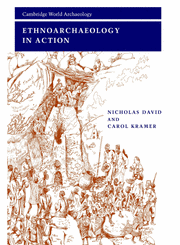Book contents
- Frontmatter
- Dedication
- Contents
- List of figures and credits
- List of tables
- Preface
- Acknowledgments
- Map
- 1 Ethnoarchaeology: its nature, origins, and history
- 2 Theorizing ethnoarchaeology and analogy
- 3 Fieldwork and ethics
- 4 Human residues: entering the archaeological context
- 5 Fauna and subsistence
- 6 Studying artifacts: functions, operating sequences, taxonomy
- 7 Style and the marking of boundaries: contrasting regional studies
- 8 Settlement: systems and patterns
- 9 Site structures and activities
- 10 Architecture
- 11 Specialist craft production and apprenticeship
- 12 Trade and exchange
- 13 Mortuary practices, status, ideology, and systems of thought
- 14 Conclusions: ethnoarchaeology in context
- Bibliography
- Index
14 - Conclusions: ethnoarchaeology in context
Published online by Cambridge University Press: 05 March 2015
- Frontmatter
- Dedication
- Contents
- List of figures and credits
- List of tables
- Preface
- Acknowledgments
- Map
- 1 Ethnoarchaeology: its nature, origins, and history
- 2 Theorizing ethnoarchaeology and analogy
- 3 Fieldwork and ethics
- 4 Human residues: entering the archaeological context
- 5 Fauna and subsistence
- 6 Studying artifacts: functions, operating sequences, taxonomy
- 7 Style and the marking of boundaries: contrasting regional studies
- 8 Settlement: systems and patterns
- 9 Site structures and activities
- 10 Architecture
- 11 Specialist craft production and apprenticeship
- 12 Trade and exchange
- 13 Mortuary practices, status, ideology, and systems of thought
- 14 Conclusions: ethnoarchaeology in context
- Bibliography
- Index
Summary
The study of material culture may be most broadly defined as the investigation of the relationship between people and things irrespective of time and space. The perspective may be global or local, concerned with the past or the present, or the mediation between the two. Defined in this manner, the potential range of contemporary disciplines involved in some way or other in studying material culture is effectively as wide as the human and cultural sciences themselves.
(Daniel Miller and Christopher Tilley 1996: 5)As ethnoarchaeology is an approach rather than a true discipline we should not expect overall progress of the kind observed in a subject like physics where research leads to ever deeper understandings of matter and energy and to applications of that knowledge. But neither is it, as in painting, a matter of the invention and perfection of techniques and the creation of masterworks that are not bettered but rather overtaken by new developments, technical and conceptual, in new historical contexts. Like other social sciences, ethnoarchaeology advances not on its own but in partnership with its disciplinary siblings, archaeology and ethnography, and within the larger context of social science and its philosophy. Early classic studies retain value but, unlike a Rembrandt masterpiece, their imperfections and lacunae (and not merely their differences) become apparent through developments in and beyond ethnoarchaeology. On the other hand, just as art students copy old masters, so too can we imbibe knowledge and know-how by analyzing earlier studies.
- Type
- Chapter
- Information
- Ethnoarchaeology in Action , pp. 409 - 421Publisher: Cambridge University PressPrint publication year: 2001

